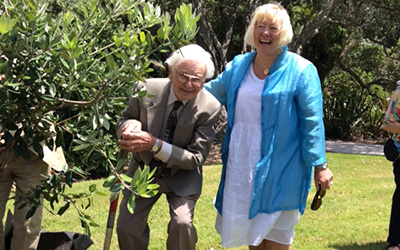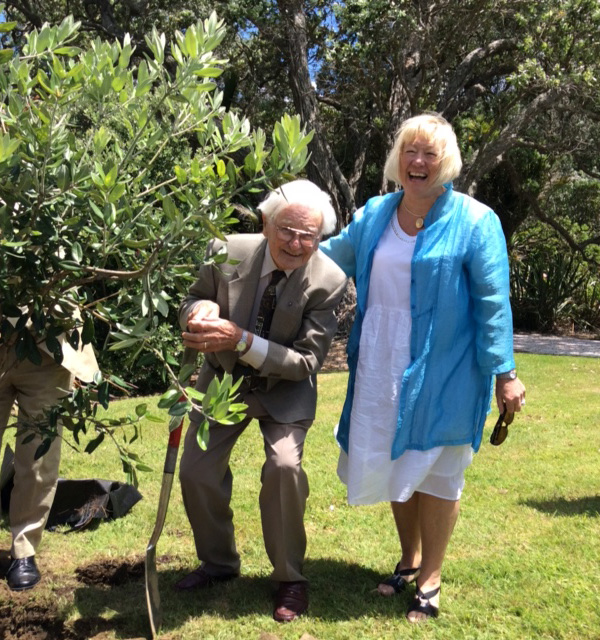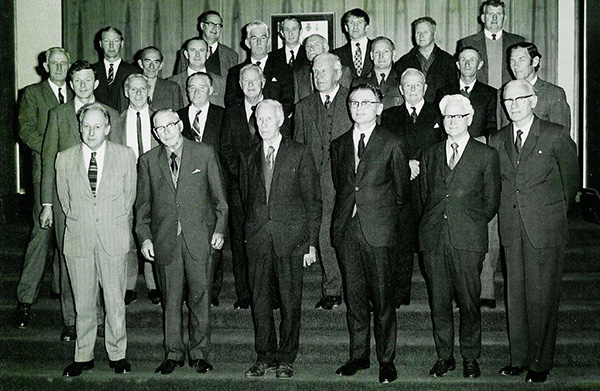Parks czar provides perfect Te Muri Christmas present


First and Current Chairs: Judge Arnold Turner, ducking for the photographer, and Councillor Christine Fletcher at the 50th anniversary of the opening of Wenderholm Regional Park. Arnold Turner CMG, then a planning lawyer, was effectively first chairman of regional parks, while Christine Fletcher is the present, chairing Auckland Council’s parks, recreation and sport committee. image Bronwen Turner
On 18 December 1965, Aucklanders awoke to a Christmas present for posterity.
Nine months earlier the region had learned that, thanks to the establishment of an authority that was able to act in the combined interests of 32 separately constituted cities, towns and boroughs, the mysterious private beach of Wenderholm had been purchased for the public.
On Friday, 130 guests attended a celebration of the opening of the gates of Wenderholm to the public. On the corresponding Saturday 50 years earlier, Aucklanders proved to be so keen to use their new beach domain that, that summer, attendance at the neighbouring Waiwera mineral pools plateaued after a period of unchecked, exponential growth that, on peak holidays, would see not just the hot pools, but the entire diminutive seaside town at bursting point.
The irony of celebrating the 50th anniversary of the public opening of Wenderholm Regional Park with an invitation-only morning tea wasn’t mentioned in the official speeches, but as Judge Arnold Turner reiterated in his excellent and detailed speech, it was he who insisted that Wenderholm be opened by the summer of 1965, which became the mother of all Christmas rushes. Mindful that many would be compromised by pre-Christmas responsibilities, further celebrations are planned for throughout 2016. These include the Mahurangi Regatta, which will enthusiastically fly the 50th anniversary flag on 30 January.
For the inevitable profusion of utterances of the phrase ‘dreamers of the day’, during the marathon of mihi and speeches, there was a dearth of dangerous ideas that that phrase should invoke in people aware of its T E Lawrence origin:
All men dream: but not equally. Those who dream by night in the dusty recesses of their minds wake in the day to find that it was vanity: but the dreamers of the day are dangerous men, for they may act their dreams with open eyes, to make it possible. This I did.
Judge Turner’s speech and presence drew a rare—for New Zealanders—standing ovation, led by former regional parks chairman Bill Burrill. By rights, guests should also have been on their feet following current parks chair Christine Fletcher’s passionate contribution, which referenced the recent attempt to dismember the regional parks network.
Were any of today’s politicians or council officers as ‘dangerous’ as the three men whose open-eyed dreams directly enabled Wenderholm’s purchase—Sir Dove-Myer Robinson, Captain Frederick W O Jones and Judge Arnold R Turner CMG—there might have been mention of one or other of the elephants in the marquee, be it the sea-level rise that will threaten Couldrey House within the next 50 years or the audacious Mahurangi Coastal Trail that would connect the first regional park with the last purchased by the regional authority before it was subsumed by Auckland Council. The failure to mention this project, much less herald it, might have blighted proceedings for those of its advocates present—invited and otherwise—had it not been for the extraordinarily encouraging meeting that took place the previous day.
The meeting was convened to explore how the regional park management plan variation in respect to Te Muri might best reflect the common ground between the dominant community desire for a coastal trail to be the principal form of access, and council officers’ unflinching belief that full road access will ultimately be necessary. Newly appointed Auckland Council parks czar Mace Ward quickly concluded that, conceptually, because of the obvious hazardousness of the State Highway 1 and Hungry Creek Road intersection, road access should not be provided until after the opening of the Pūhoi–Warkworth motorway, and that meantime the coastal trail project should be allowed to progress through the resource consent application process. Whether the management plan variation does in fact reflect that reasonable position will depend upon the recommendations of the three commissioners, however the senior parks planning officer has been asked to work with the trail proponents to ensure that the commissioners are cognisant of the common ground. This understanding, however, acknowledges that other considerations may surface during the formal public submission process that will run from 15 January to 18 March 2016. When the management plan variation finally takes effect, in June 2016, it is unlikely to please everyone. The predominant sentiment amongst Te Muri adherents is that there should be no change whatsoever that would result in greater visitor numbers. But this expectation is as unreasonable as it is unrealistic, given the considerable investment made on behalf of Aucklanders at large. If not the 1973 purchase of Te Muri’s coastal margin but certainly the 2010 purchase of its pastoral hinterland for $15 million made it inevitable that this regional parkland would one day host thousands of visitors, of a popular holiday weekend, when there are currently typically fewer than a hundred. Most when apprised of the options—access by car, or access by coastal walkway—opt resignedly for the latter, but many nonetheless are implacably and determinedly opposed to any change that would increase visitor numbers.

Instigator Obscured but Not Omitted: Frederick W O Jones, right of centre in second row from back, might be partly obscured in this 1986 photograph but his role as the original Auckland Regional Parks instigator was praised by Judge Arnold Turner, front row, third from right. The occasion was the retirement of Arthur D Mead who was closely involved, from 1939, with the first parkland acquired in the spirit of a regional park—Auckland Centennial Memorial Park, part of what is now the Waitākere Ranges Regional Park. image Arnold R Turner CMG archive
Contemporary dangerous dreamers of the day believe that the sense of splendid isolation revered by Te Muri adherents can be retained while addressing the needs of Aucklanders for the next 50 years—their post-Paris needs. A Mahurangi Coastal Trail, incurring an inconsequential amount of greenhouse gas emissions either during construction or thereafter, would put the greater 900-hectare regional park Mahurangi regional park within an easy bus ride of the minimum of two million people projected to live in the region within 17 years. But to ensure that park visitor pressure is not densely concentrated on the finite dozen hectares of flat land adjacent the beach, great care is called for in devising incentives for visitors to use and enjoy the hills that afford so many attractive places to walk or ride and to enjoy the endless vistas. An example is the coastal trail route itself, which, as it gently climbs towards the saddle of Te Muri, provides a succession of vistas of Wenderholm. This, many will discover, is the ultimate way to enjoy Wenderholm when is heaving with peak-time visitor crowds.
For a far more dangerous dream, consider a world-class restaurant sited at a strategic location along the old Schischka farm road, accessed by foot and by bridle trail only, and smack on Te Araroa, the national walkway. This would incentivise folk to experience the more rural part of the park, where otherwise few of the visitors—who are there emphatically for the beach—would ever venture. Those camping at Te Muri, for example, of evening, rather than prepare yet another meal over the camp gas cooker, could take one of the many tracks that would lead up to the ridgeline, 100 metres above sea level. And, after an evening in the incomparable ambience of places that are achievable only after the investment modicum of determination, stroll home to their campsite. Such an establishment would also serve as a welcome watering hole for people walking to Te Muri from Pūhoi. Unless Te Muri is developed very deliberately and intelligently, 99% of the visitor activity will be congested on the fragile and finite 12-hectare coastal margin, and the 407-hectare Schischka farm would serve as little more than an excruciatingly expensive driveway to a badly over-crowded beach.
Thanks to the early Christmas presents of 1965 and 2015, a dangerous dream commensurate with the beauty of Te Muri’s rare and precious isolation could still be realised.
